Background. Source copy is in Orbis, an LC record from the 40's created by RECON. No usable cataloging copy in OCLC. Book in hand has a vendor record in Orbis.
Source copy:
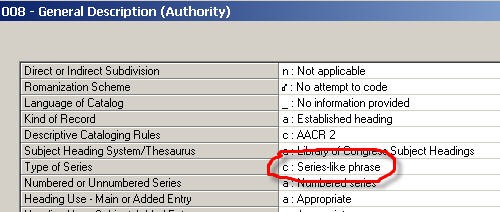
Record to be cataloged:
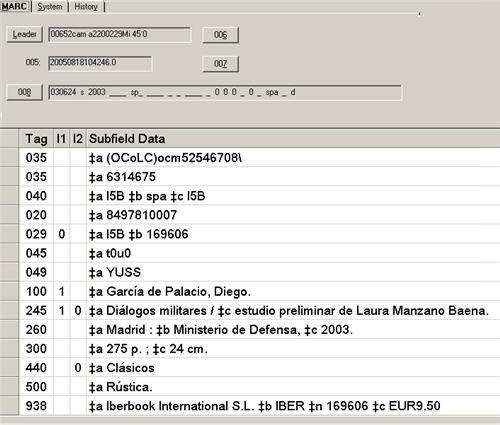
Post-editing:
Comments:
Because the source copy uses pre-ISBD punctuation and the vendor has supplied basic description using ISBD, a better technique in this case is to edit the record for the new edition directly rather than use copy and paste or the Voyager copy command.
Variable fields are deleted from the vendor record: 035 6314675, 029, 045, 500, and 938.
In 040 the $b in the vendor record indicates it was created by a non-English language cataloging agency. Since we do not want our record to set its holdings on the Spanish-language master record, delete the 035 for the OCLC id number and replace the 040 as indicated.
020 matches the book to be cataloged but was out of sequence; editing moves the field to follow MARC numerical order.
The 050 00 on the source record can't be used since it is a classed-together number for a different series. Since there are no other editions in Orbis or OCLC that have a classed separately, the number needs to be assigned by a cataloger who has authorization to use ClassWeb. The class number assigned correlates to other bibliographic records with primary subject Military art and science--Early works to 1800.
The authority record for Garcia de Palacio was recently upgraded to RDA form. The use of the fl. abbreviation is no longer used and is replaced with active. Current practice is to add a $e author relationship designator.
The 245 introduces the name Laura Manzano Baena which is not associated with the source bibliographic record. Note other differences between what was in the source record 245 and what is transcribed in the record for the book being cataloged. Note that the source record does not use ISBD punctuation, but the vendor has done so for field 245 and all of the other descriptive fields.
The vendor has not bracketed Madrid. The place of publication does not appear on the item, but can be inferred, so it is entered in brackets. CIP on the verso t.p. provides the information about the place of publication in bracketed form, and it seems reasonable to accept this.
However, the 2015 date of publication in the CIP is not reliable. Although there is a copyright date of 2014 on the verso t.p., there is actually no explicit publication date. The following appear on the verso t.p.: "Depósito Legal: M-19951-2014" and "Fecha de edición: abril 2015." Neither are considered publication dates (the latter is a printing date). A date (i.e. 2015) appearing in a CIP on the t.p. verso is not considered a publication date either. In current RDA cataloging (as interpreted by the LC-PCC policy statements), in the absence of a publication date the copyright date is used as the substitute, and is entered in brackets.
The publication date is recorded in 008 as Date Type s (single) Date/1 2014 Date 2/blank. This is a judgment call. The main text is a photocopy reprint of the 1583 publication but the substantial introduction can qualify it as a new edition rather than a Date Type r Date 1/2002 Date 2/1583. Items in this series are reprints; none of the titles were treated as reprints in 008 in other cataloged records.
Field 300 was edited to RDA standards; "pages" was spelled out, "illustrations" was added to subfield ‡b. The corresponding 008 field for illustrations has been updated.
The vendor has not transcribed the series correctly in 440 and has not used the authorized form. As the authority validation window indicates, the form used on the vendor record is a reference, not the established form of the series.
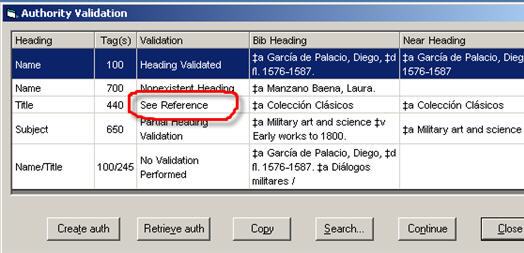
However, note that the reference is to a different series.
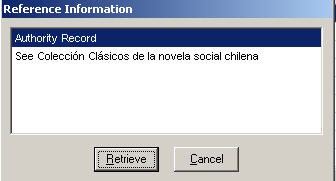
NOTE: since the reference might cause a problem with MARS processing, consult with a cataloger authorized to do NACO work in order to update the authority record for the other series.
Although the Voyager Authority Verification does not retrieve the series authority record for the series on your book, that does not mean your series has not been established. You will need to search further in Orbis.
A Staff Title search on "Colección Clásicos" retrieves 86 headings.
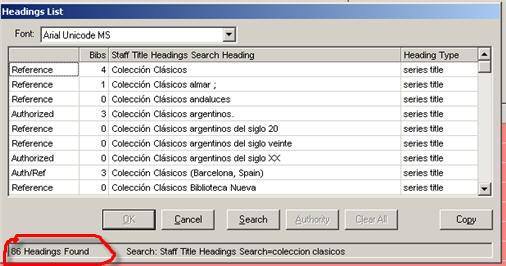
TIP: A quick way to find the series authority record is to use a "keyword in staff" search. Since there are many series beginning with "Colección Clásicos," the series is probably qualified. The qualifier is usually by place or publisher.
Here is a "keyword in staff" search using "Madrid" as the qualifier:
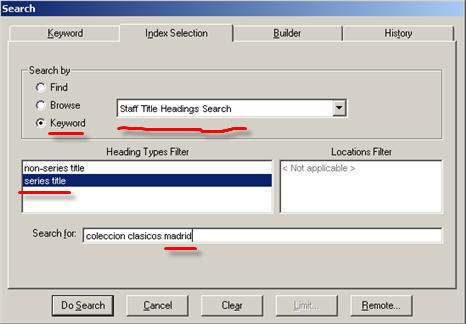
In this case, the Madrid qualifier has already been used for a different series:
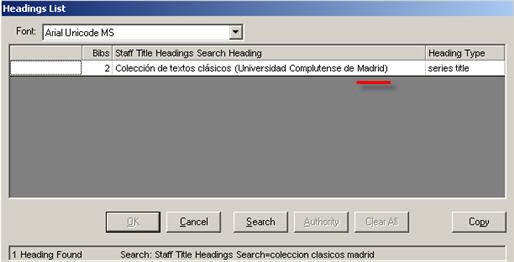
The other likely qualifier is the issuing body for the series. Since this is keyword searching, choose the least common term as the qualifier ("defensa") to reduce the number of records retrieved.
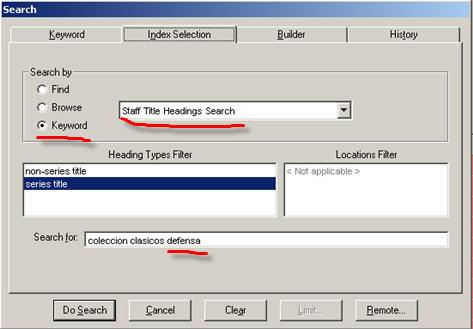
This retrieves the series authority needed:
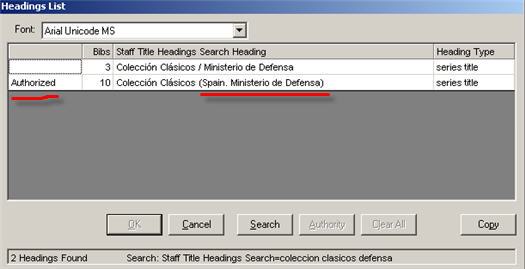
The authority record:
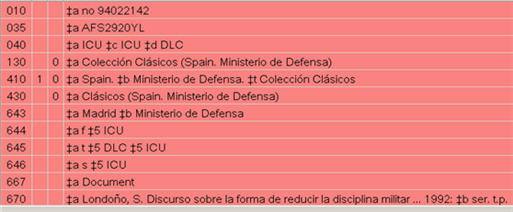
If no record had been found, you would then have had to do a regular "find" type Staff Title Search and scrolled through the headings until you identified the appropriate series heading.
Because the series requires a qualifier, it has to be recorded in 490 1/830 form. Copying and pasting from the Series Authority Record is recommended, especially since diacritics are involved.
The subject subdivision on the source record is obsolete, something to watch out for when using old cataloging. A subject browse search on Military art and science--To 1800 in LC Online Catalog retrieves only one record. A search on Military art and science--Early works to 1800 retrieves over 600 records. Note that the subdivision is coded ‡v. Have a cataloger with a Cataloger's Desktop authorization check the Free-floating subdivisions list if necessary.
Headings. Garcia de Palacio is established. A 700 for Laura Manzano Baena is justified based on a scholarly introduction that is 25% of the publication. No NAR has been made for Manzano Baena. Your unit may have guidelines on whether to make a NAR for compound surnames. YUL generally creates a NAR only when a reference is needed. In AACR2 a reference from the second surname was mandatory, but under current RDA and NACO guidelines, variant forms are not required. Authors of introductions are not assigned the relationship designator "author." There may be a suitable relationship designator for the writer of an introduction, but it is not mandatory.
